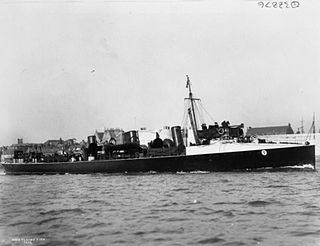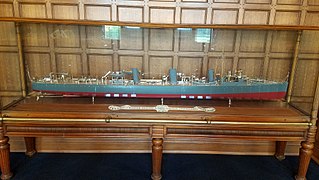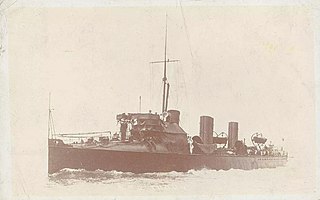HMS Electra was a Clydebank-built, three-funnelled, 30-knot destroyer ordered by the Royal Navy under the 1895–1896 Naval Estimates. She was the fourth ship to carry this name since it was introduced in 1806 for a 16-gun brig-sloop.

HMS Crane was a Palmer three-funnel, 30-knot destroyer ordered by the Royal Navy under the 1895–1896 Naval Estimates. She was the sixth ship to carry this name since it was introduced in 1590 for a 24-gun schooner in service until 1629.

HMS Flying Fish was a Palmer three funnel, 30 knot destroyer ordered by the Royal Navy under the 1896 – 1897 Naval Estimates. She was the tenth ship to carry this name.
HMS Avon was a Vickers three-funnel, 30-knot destroyer ordered by the Royal Navy under the 1895–1896 Naval Estimates. She was the fifth ship to carry this name since it was introduced in 1805 for an 18-gun brig-sloop, sunk in 1847.
HMS Otter was a Vickers three-funnel, 30-knot destroyer ordered by the Royal Navy under the 1895–1896 Naval Estimates. She was the fourth ship to carry this name since it was introduced in 1782 for a fire ship, sold in 1801.

HMS Violet was a Doxford three-funnel, 30-knot destroyer ordered by the Royal Navy under the 1896–1897 Naval Estimates. She was the seventh ship to carry this name since it was introduced in 1588 for a 200-ton vessel.
HMS Sylvia was a Doxford three funnel - 30 knot destroyer ordered by the Royal Navy under the 1896 – 1897 Naval Estimates. She was the sixth ship to carry this name since it was introduced in 1806 for a cutter sold in 1816.

HMS Mermaid was a Hawthorn Leslie three-funnel, 30 knot destroyer ordered by the Royal Navy under the 1896 – 1897 Naval Estimates. She was launched in 1898, served during World War I and was sold for breaking in 1919.

HMS Greyhound was a Hawthorn Leslie three-funnel, 30 knot destroyer ordered by the Royal Navy under the 1898 – 1899 Naval Estimates.
HMS Osprey was a three-funnel, 30-knot destroyer ordered by the Royal Navy under the 1896–1897 Naval Estimates from Fairfields. She was the fifth ship to carry this name since it was introduced in 1797 for an 18-gun ship-sloop.

HMS Bullfinch was a three-funnel, 30-knot destroyer ordered by the Royal Navy under the 1896–1897 Naval Estimates. She was the third ship to carry this name since it was introduced in 1857 for a 4-gun wooden-screw gunboat.

HMS Coquette was a two funnel, 30-knot destroyer ordered by the Royal Navy under the 1896 – 1897 Naval Estimates. She was the fifth ship to carry this name. She was launched in 1897, served in home waters before World War I, and as a tender to the gunnery school at Sheerness during the war. She was sold for breaking in 1920.

HMS Cygnet was a two funnel, 30 knot destroyer ordered by the Royal Navy under the 1896–1897 Naval Estimates. She was the thirteenth ship to carry this name. She was launched in 1898, served in the Chatham division before World War I and was tendered to the gunnery school at Sheerness during the war. She was sold for breaking in 1920.

HMS Fawn was a Palmer three funnel, 30 knot destroyer ordered by the Royal Navy under the 1896 – 1897 Naval Estimates. She was the fourth ship to carry this name.
HMS Lee was a Doxford three funnel - 30 knot destroyer ordered by the Royal Navy under the 1898 – 1899 Naval Estimates. She was the sixth ship to carry this name since its introduction in 1776 for a 6-gun sloop for service on the Great Lakes.
HMS Vixen was a Vickers three funnel - 30 knot destroyer ordered by the Royal Navy under the 1895 – 1896 Naval Estimates. She was the fourth ship to carry this name since it was introduced in 1801 for an 18-gun brig sold 1815.

HMS Vulture was a Clydebank three funnel - 30 knot destroyer ordered by the Royal Navy under the 1895 – 1896 Naval Estimates. She was the fifth ship to carry this name since it was introduced in 1776 for a 14-gun sloop sold until 1802.

HMS Thorn was a Clydebank three funnel - 30 knot destroyer purchased by the Royal Navy under the 1899–1900 Naval Estimates. She was the second ship to carry this name since it was introduced in 1779 for a 16-gun sloop sold in 1816.
HMS Vigilant was a Clydebank three-funnel, 30-knot destroyer purchased by the Royal Navy under the 1899–1900 Naval Estimates. She was the ninth ship to carry this name since it was introduced in 1755 for an 8-gun schooner captured in 1756 by the French at Oswego.

HMS Falcon was a Fairfield three-funnel, 30 knot destroyer ordered by the Royal Navy under the 1898 – 1899 Naval Estimates. She spent her life in Home waters, was part of the Dover Patrol during World War I and was lost in a collision on 1 April 1918.
NOTE: All tabular data under General Characteristics only from the listed Jane's Fighting Ships volume unless otherwise specified









